



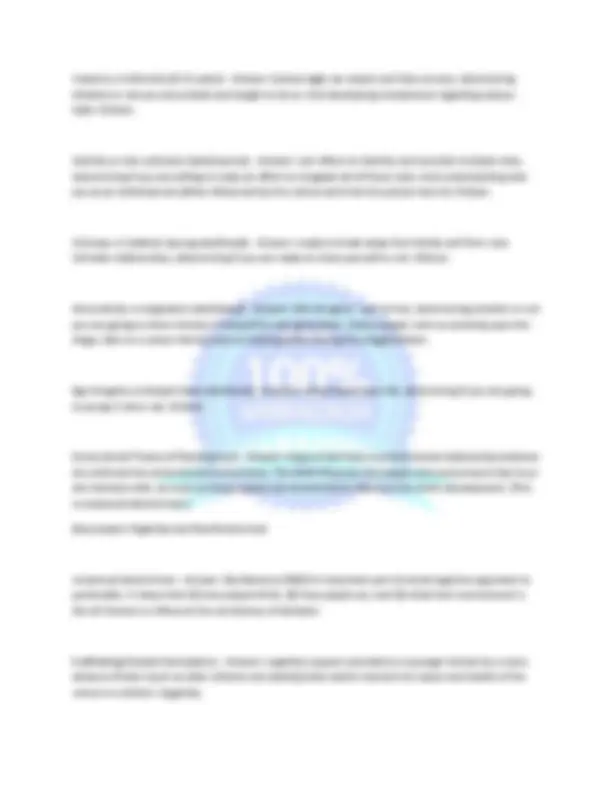


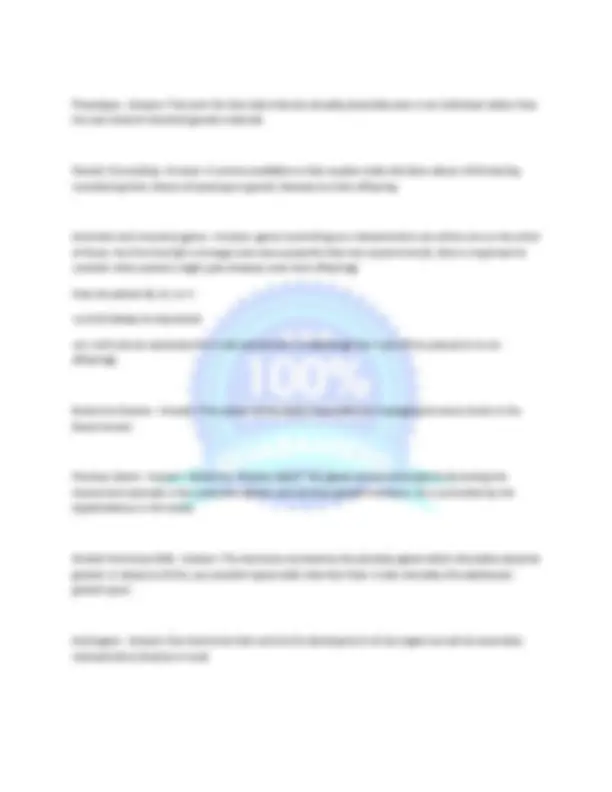
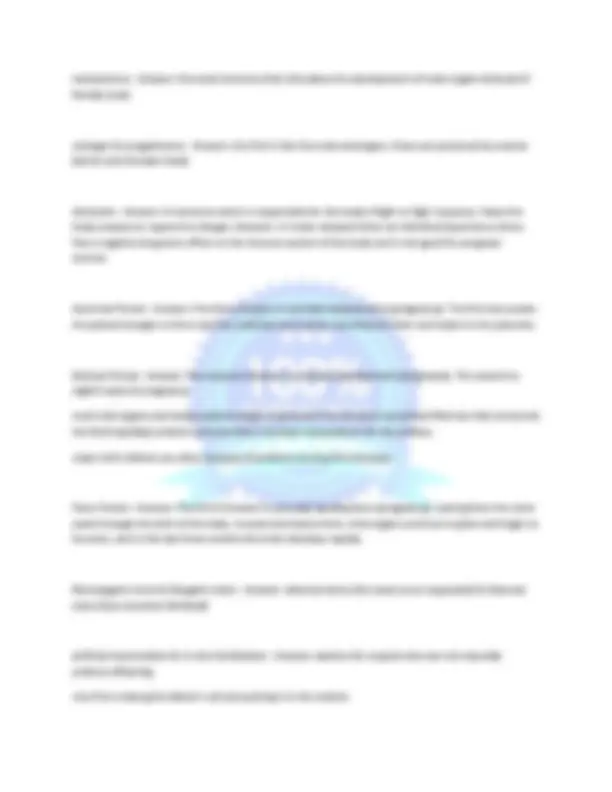





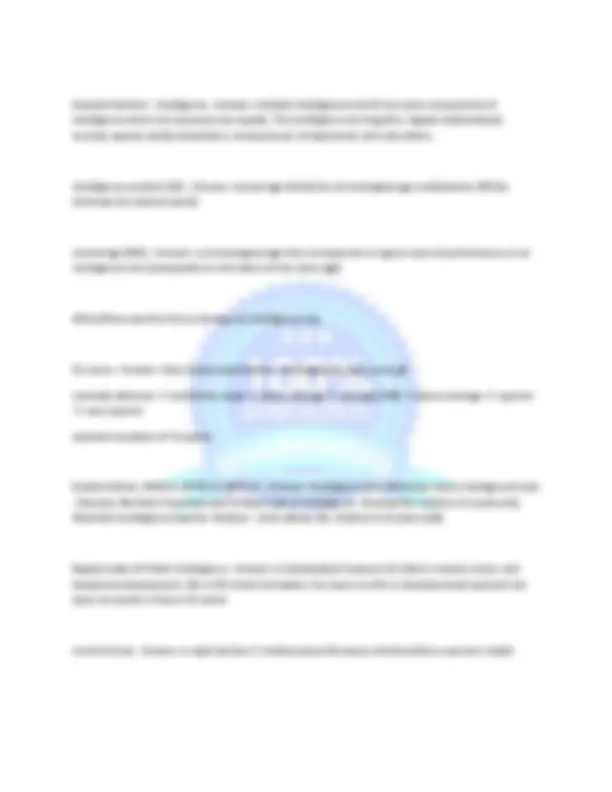

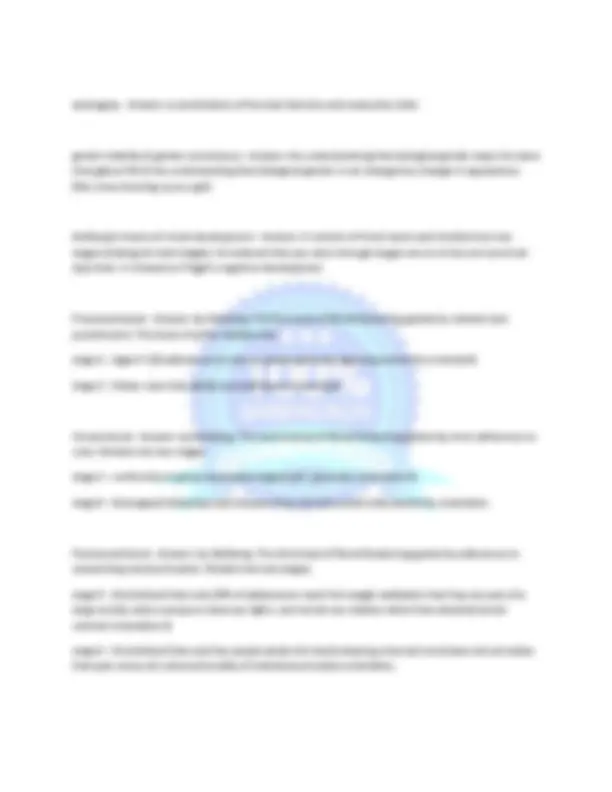
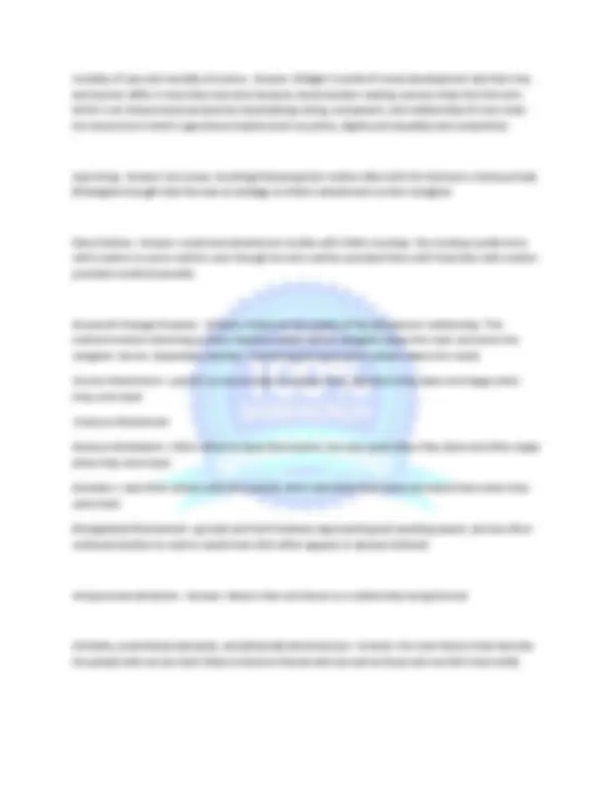







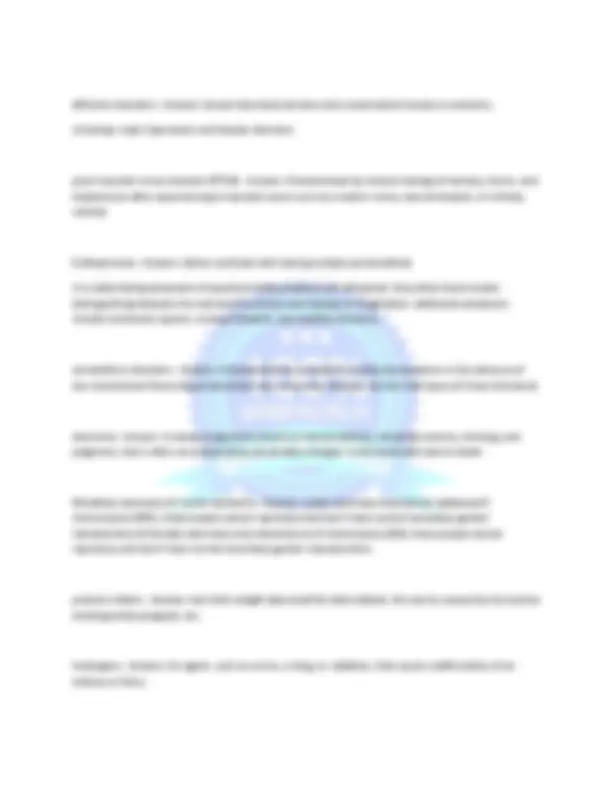








Study with the several resources on Docsity

Earn points by helping other students or get them with a premium plan


Prepare for your exams
Study with the several resources on Docsity

Earn points to download
Earn points by helping other students or get them with a premium plan
Community
Ask the community for help and clear up your study doubts
Discover the best universities in your country according to Docsity users
Free resources
Download our free guides on studying techniques, anxiety management strategies, and thesis advice from Docsity tutors
HUMAN GROWTH AND DEVELOPMENT CLEP / NEWEST ACTUAL EXAM COMPLETE 200+ QUESTIONS AND CORRECT DETAILED ANSWER nature vs. nurture controversy - Answer--it is agreed that both have some influence in development, but some people think it is more one than the other. biologically built vs. environment tabula rasa - Answer--this is what the human mind is at birth (according to the nurture side of the nature versus nurture controversy), like a blank slate that experience writes on Discontinuity or Stage Theories - Answer--Argues that development progresses through a series of stages. Each stage involves a specific task. Once the stage is completed the child moves on to the next stage. The developing person is changing qualitatively, not quantitatively. Continuity Theories - Answer--Suggest that development is best described as a steady
Typology: Exams
1 / 39

This page cannot be seen from the preview
Don't miss anything!
































nature vs. nurture controversy - Answer--it is agreed that both have some influence in development, but some people think it is more one than the other.
biologically built vs. environment
tabula rasa - Answer--this is what the human mind is at birth (according to the nurture side of the nature versus nurture controversy), like a blank slate that experience writes on
Discontinuity or Stage Theories - Answer--Argues that development progresses through a series of stages. Each stage involves a specific task. Once the stage is completed the child moves on to the next stage. The developing person is changing qualitatively, not quantitatively.
Continuity Theories - Answer--Suggest that development is best described as a steady growth process. Developmental change is described as occurring in small steps or increments. (Skills and behavior improve but they do not change in a qualitatively.)
Child Development vs. Life Span - Answer--Some theories of development argue that development is complete at the end of childhood/adolescence (Sigmund Freud and Jean Piaget are examples).
Life Span theories of development argue that growth and change continue to occur throughout the entire life span (Erick Erickson took a life span perspective).
universality vs. context specific - Answer--a theory that applies to all cultures and time periods (such as Piaget proposed for his theory)
Bronfenbrenner is an example of the alternative view which points out that there are differences in development depending on the culture/environment (such as in collectivist cultures versus individualistic cultures)
Collectivist cultures - Answer--Places greater value on the common good than individual achievement
Individualistic cultures - Answer--values individual achievements and the pursuit of individual goals
accommodation - Answer--by Piaget. modifying an existing scheme
assimilation - Answer--by Piaget. taking new information from the world and incorporating it into an existing scheme
Scheme - Answer--by Piaget. basic thought about the world, objects, events
disequilibrium - Answer--what happens when a child understands the world in a particular way (their scheme) then sees something happen that can't fit into that understanding.
constructivism - Answer--Piaget's position that argues that children construct schema (organized patterns of thought or action) based on experiences they have actively exploring the environment.
Piaget's stages of cognitive development - Answer--sensorimotor, preoperational, concrete operations, formal operations (each stage represents a qualitatively different way of thinking instead of just acquiring more information over time)
learning theory or the behaviorist perspective - Answer--describes developmental change as a product of learning (nurture side of nature vs. nurture & are continuity theories). Learning is a change in observable behavior (and behavior is controlled by stimuli in the environment).
(key people: Pavlov, Watson, Skinner, Bandura)
John Watson - Answer--founded the Behavioral Psychology in 1913. (he believed that at birth we only have these emotions: love, anger, and fear)
learning theory/the behaviorist perspective = describes developmental change as a product of learning (nurture side of nature vs. nurture & are continuity theories).
Pavlov's classical conditioning - Answer--(sometimes called type S (stimulus) conditioning)
Making a connection between two stimuli. The US already produces the UR (together producing a reflex) which is the desired response to the neutral stimulus.
{First letter = unconditioned(maybe UC)/conditioned
Second letter = stimulus/response}
Before conditioning: US -> UR
Conditioning: neutral stimulus [-> no response] + US -> UR
After learning: CS -> CR (unless the original S is taken away, which would lead to extinction aka going back to the original behavior)
higher conditioning = when a new neutral stimulus is associated with a CS
Stimulus generalization - Answer--When something from conditioning (or uncondtioned) carries over to another related area. You are afraid of spiders, you might become afraid of other bugs because they are so similar.
stimulus discrimination - Answer--only showing the reflexive classical conditioning (or UC) response for the specific/exact stimulus (not similar ones like generalization)
Watson and Little Albert - Answer--The psychologist classically conditioned the infant to be afraid of a white rat, by pairing the white rat (a neutral stimuli) with a frightening, loud noise, causing the infant to associate the rat with the noise.
type R (response) or operant conditioning - Answer--by Skinner.
-Reinforcement is to increase (+) the behavior.
-Punishment is to decrease (-) the behavior.
-Positive is introducing something.
-Negative is taking away something.
Shaping - Answer--A form of behavioral modification for getting a subject to start performing a preferable behavior by reinforcing components of the desired behavior and gradually rewarding more discriminatively (similar actions are reinforced in a way that leads them to the desired goal).
social learning theory/social cognitive theory - Answer--by Bandura.
changes in behavior are acquired not only by conditioning but also through observational learning (learning from models, which requires attention, retention, reproduction of the action, and motivation/a motive)
vicarious reinforcement and vicarious punishment - Answer--seeing others reinforced or punished (respectively) for certain behaviors influences how the viewer behaves
psychodynamic/psychoanalytic personality theories - Answer--(most hold that personality is mainly unconscious) descendants of/based on Freud's theories.
(key people: Freud and Erikson)
Sublimation - Answer--A useful socially acceptable course of behavior replaces a socially unacceptable or distasteful impulse. ex. A person who feels aggression due to lack of control, plays an aggressive game of basketball with friends everyday. (A defense mechanism recognized by Freud.)
Intellectualization - Answer--By dealing with a stressful situation in an intellectual and unemotional manner, a person detaches him or herself from the stress (A defense mechanism recognized by Freud.)
denial - Answer--not admitting/acknowledging that a very unpleasant thing has happened (A defense mechanism recognized by Freud.)
Freud's Psychosexual Stages - Answer--Oral (birth - 1 year : mouth), Anal (1-3 years : potty training), Phallic (3-6 years : boy-girl-mom-dad-thing), Latency (6-11 years : none), Genital (adolescence : marriage)
Freud said that these develop personality depending on how they are dealt with. (the first three being the most important)
Erikson's theory of psycho-social development - Answer--(a psychodynamic theory of personality)
It says that people go through 8 stages in their life (each involving a different crisis). Depending on how the person deals with/comes out of each stage determines and develops their personality.
trust vs. mistrust (birth-1 year) - Answer--dependence on others, determining if others are reliable. Erikson.
autonomy vs. shame and doubt (1-3 years) - Answer--capable of self control, determining how you are allowed to exercise freewill. Erikson.
initiative vs guilt (3-6 years) - Answer--(in preschool) can set goals, determining if initiative is encouraged. Erikson.
Industry vs inferiority (6-11 years) - Answer--(school age) can reason and likes success, determining whether or not you are praised and taught to do so. And developing competence regarding various tasks. Erikson.
Identity vs role confusion (adolescence) - Answer--can reflect on identity and consider multiple roles, determining if you are willing to make an effort to integrate all of those roles. And understanding who you as an individual are (often influenced by the culture and time the person lives in). Erikson.
Intimacy vs Isolation (young adulthood) - Answer--ready to break away from family and form new intimate relationships, determining if you are ready to share yourself or not. Erikson.
Generativity vs stagnation (adulthood) - Answer--kids are gone - you're free, determining whether or not you are going to show interest in others/the next generation. (some people, who successfully pass this stage, take on a career that focuses on helping others during this stage) Erikson.
Ego integrity vs.Despair (Late adulthood) - Answer--reflecting on your life, determining if you are going to accept it all or not. Erikson.
Sociocultural Theory of Development - Answer--Argues that there is a bidirectional relationship between the child and the sociocultural environment. The child influences the people and environment that he or she interacts with, as much as those people and environments influence the child's development. (This is reciprocal determinism.)
(key people: Vygotsky and Bronfenbrenner)
reciprocal determinism - Answer--(by Bandura 1986) An important part of social-cognitive approach to personality. It shows that (1) how people think, (2) how people act, and (3) what their environment is like all interact to influence the consistency of behavior.
Scaffolding/Guided Participation - Answer--cognitive support provided to a younger thinker by a more advance thinker (such as older children and adults)/older adults transmit the values and beliefs of the culture to children. Vygotsky.
ethology and evolutionary psychology - Answer--sees human development based on Darwin's theory of evolution
(key people: Konrad Lorenz and John Bowlby)
Critical period - Answer--(called the sensitive period in humans & by evolution theorists) a specific period in development when a certain event will have the greatest impact/must be developed.
sample & population - Answer--a representative subset of a population (in other words, less than all of the people from the population) & all of the people who fit under a particular category (such as all Americans, all high-school students with an eating disorder, etc.)
random sample - Answer--The term used for a sample of the target population that has been drawn using sampling technique that gave every member of the target population an equal chance of being selected (unlike biased sampling).
Experiments - Answer--A researcher manipulates variables to test theories, conclusions, and cause and effect relationships. Has independent and dependent variables. Researchers have direct control over the independent variable.
Independent Variable - Answer--Is the variable that is being manipulated (also the "cause")
dependent variable - Answer--The variable that is measured after the manipulation of an independent variable in an experiment. it is the hypothesized effect in the cause and effect relationship being tested.
experimental group & control group - Answer--exposed to the cause & not exposed to the cause/normal treatment
quasi-experiment (field experiment) - Answer--the researcher cannot control some of the variables of interest in the study and (unlike in the experimental design) cannot randomly assign participants to treatment conditions. This is done in natural settings.
placebo effect & placebo & double blind study - Answer--different behavior because the subject knows they are being tested/getting special treatment & fake special treatment & both experimenter and experimetee are unaware of who has recivied special treatment
correlational studies - Answer--assessing the relationship between two variables (excluding cause and effect relationships). This can be done in natural or laboratory settings.
factors can have a positive, negative, or no correlation (rise in one factor corresponds in rise in another factor or rise in one factor corresponds to a fall in another factor, respectively)
correlation coefficient - Answer--(+/-)1, the higher the absolute value = more correlation, +/- indicates type of relationship, 0 is no relationship
Descriptive or Observational Research - Answer--Methods used to obtain accurate records of behavior without manipulating or controlling any variables.
(includes naturalistic observation, case studies, and survey research/interviews)
naturalistic observation - Answer--studying behavior as it occurs in real life settings
must be unobtrusive, and have inter-judge/inter-rater/inter-observer reliability (the confirmation by more than one person of what is happening)
case studies - Answer--in-depth analysis of only one person (Freud used these a lot).
cross-sectional study - Answer--Comparing people who are at different ages from each other at a single point in time.
cohort - Answer--a group of people born during the same period of time (generation). Cohorts make it hard to tell whether it is a factor of age or a factor of differences in the periods of time in which the subjects grew up.
Phenotype - Answer--The term for the traits that are actually physically seen in an individual rather than the sum total of inherited genetic material
Genetic Counseling - Answer--A service available to help couples make decisions about child bearing considering their chance of passing on genetic diseases to their offspring
dominant and recessive genes - Answer--genes controlling our characteristics are either one or the other of these. the first kind (d) is stronger and more powerful than the second kind (r). (this is important to consider when parents might pass diseases onto their offspring)
they are paired dd, dr, or rr
-a d will always be expressed
-an r will only be expressed if it is not paired with a d (although the r can still be passed on to an offspring).
Endocrine System - Answer--The system of the body responsible for managing hormone levels in the blood stream
Pituitary Gland - Answer--Called the "Master Gland" this gland control other glands (including the thyroid and adrenal) in the endocrine system and secretes growth hormone. (It is controlled by the hypothalamus in the brain)
Growth Hormone (GH) - Answer--The hormone secreted by the pituitary gland which stimulates physical growth. In absence of this, you wouldn't grow taller than four feet. It also simulates the adolescent growth spurt.
Androgens - Answer--Sex hormones that control the development of sex organs as well as secondary characteristics (mainly in men)
testosterone - Answer--the male hormone that stimulates the development of male organs (instead of female ones)
estrogen & progesterone - Answer--the first is like the male androgens. these are produced by ovaries (which only females have)
Adrenalin - Answer--A hormone which is responsible for the body's flight or fight response. Helps the body prepare to respond to danger; however, It is also released when an individual experience stress. Has a negative long-term effect on the immune system of the body and is not good for pregnant women.
Germinal Period - Answer--The first trimester in prenatal development (pregnancy). The first two weeks. the placenta begins to form and the umbilical cord carries nourishment from and waste to the placenta.
Embryo Period - Answer--The second trimester in prenatal development (pregnancy). The second to eighth week of pregnancy.
most vital organs and bodily systems begin to grow and the amniotic sac (a fluid filled sac that surrounds the forming baby) protects and provides a constant temperature for the embryo.
major birth defects are often because of problems during this trimester.
Fetus Period - Answer--The third trimester in prenatal development (pregnancy). Lasting from the ninth week through the birth of the baby. muscles and bones form, vital organs continue to grow and begin to function, and in the last three months the brain develops rapidly.
Monozygotic twins & Dizygotic twins - Answer--identical twins (the same ovum separates) & fraternal twins (two ova were fertilized)
artificial insemination & in vitro fertilization - Answer--options for couples who can not naturally produce offspring.
-the first is taking the father's cell and putting it in the mother.
gross motor skills - Answer--coordination of large parts of the body. children generally master these before fine motor skills (coordination of small parts of the body, such as fingers)
infant physical growth - Answer--the average newborn is 20 inches long, and weighs 7-7.5 pounds. infants reach about half their adult height by two years old (which makes infanthood a time of rapid physical development/growth spurt)
puberty - Answer--achieving full sexual maturity
menarche & spermarche - Answer--the first menstrual cycle (female bleeding) a girl has. this is generally thought of a sign that she has reached puberty, although some girls cannot reproduce for several years after this. (the average age this happens is 12.5 but it could range from 11-15 years old) & the male equivalent (first ejection)
obesity - Answer--weighing 20% more than average for your age. this is a concern in adolescents as well as adults because their metabolism slows down from childhood. being overweight causes much more concern/risk of medical problems.
climacteric/menopause - Answer--(only in females) typically for 10 years in early 50s, makes the women unable to have more kids (barren). associated with mood fluctuations, hot flashes, and night sweats.
osteoporosis - Answer--bone disease where bones are brittle and fracture easily (typically in elderly people)
habituation - Answer--repeated presentations of stimuli reduces responses to that stimulus
i.e. clock chiming
sensation & perception - Answer--taking outside stimulus into neural energy to be used for perception & mentally assigning meaning to the sensation
Neonate - Answer--Another name for newborn.
cataracts - Answer--clouding on the lens of the eye (they can lead to blindness if they aren't treated)
intermodal - Answer--using more than one sense in combination (which results in us associating certain sounds, sights, etc. For example, the smell of bacon makes us think of how bacon looks, etc.)
absolute threshold - Answer--minimum intensity necessary to detect a stimulus (defined as detected 50% of the time it is present)
visual acuity - Answer--a new born's eyesight is 20/400 to 20/800, but gets better rapidly over the first four months. newborns can track a moving object, but they move their whole head instead of just their eyes.
perceptual consistency - Answer--the four kinds are: size, shape, brightness/lightness, and color
these help us to recognize object even in different situations/environments
glaucoma & presbyopia - Answer--a build-up of pressure from excess fluid inside the eyeball (common in people over 50 years old) & difficulty seeing close objects (common after the mid-late 40 years old)
presbycusis - Answer--the loss of hearing associated with old age
(Note: taste and smell also become less sensitive/sharp as people get old. smell gets worse than taste, especially in males)
concept & prototype - Answer--a basic element of thought that represents a class of objects, people or events that share common qualities & objects or events that best represent a concept that has many varying aspects
inductive and deductive reasoning - Answer--from specific to general & from general to specific
wisdom - Answer--insight into the practical problems of life. it is generally thought that you get more of this as you get older, however it comes more from the quality and richness of lived experience than age
metacognition - Answer--knowing and doing methods of learning/remembering efficiently and effectively (what works best and helps for us)
Siegler's observations about problem solving - Answer--3 year-olds guess, 4-5 year-olds select information they deem to be important and form a rule (to solve the problem) using that information, by age 12 children are good at determining all of the relevant information to the problem and and then forming a rule to apply in solving it
selective attention - Answer--paying attention to specific information while ignoring other distracting stimuli (the latter seems to decline with age)
unoccupied/functional/sensorimoter, onlooker play, parallel, associative/adjacent, cooperative, and pretend/imaginary - Answer--physical and by one's self & receiving enjoyment when watching other people play & two kids playing by themselves but next to each other & playing with each other and using the same toys but not having a common goal & playing with others & acting like someone that they are not and doing things that they are not actually doing (this last one is a type of play not a stage of play)
HOME (Home Observation for Measurement of the Environment) - Answer--by Caldwell and Bradley. It assesses the amount of intellectual stimulation in the household (looking at appropriate play materials, parental involvement, etc.) High scores correlate in high IQ scores and vise vera (this is the case for European-American and African-American households but not Mexican-American).
Phonemes & Morphemes - Answer--The smallest unit of sound that affects a word's meaning (there are 53 in English). & The smallest meaningful units in a language.
Semantics & Phonetics - Answer--The study of the meaning behind words. & The study of how sounds are put together to make words.
psycholinguistics - Answer--Study of how language is acquired, produced, and used, and how the sounds and symbols of language are translated into meaning
Syntax & Pragmatics - Answer--The proper arrangement of words in a sentence (aka grammar). & The study of the social aspects of language use.
transformational grammar theory - Answer--by Chomsky. It differentiates between surface structure (way words are organized) and deep structure (what it means). When we hear a sentence we transform the surface structure into the deep structure.
bottom up & top down - Answer--starting with what is actually present and translating it into meaning & starting with expectations, motives and cues and using them to interperet raw data
Semantic Overextension and Overgeneralization - Answer--when a child uses one word to cover many different concepts and meanings (for example: calling all animals a cat)
Fast Mapping - Answer--Coined in 1978 by Susan Carey and Elsa Bartlett. The process through which new words and concepts are learned after a single exposure (such as during the two-word stage of young children).
overregularzation - Answer--Act of inappropriately applying the grammatical rules for forming plurals & past tenses to irregular nouns & verbs
expansions & recasts - Answer--when a mother repeats a child's verbalization after making it more complex & repeating a child's utterance after correcting grammatical mistakes
language development - Answer--cooing (noises included in every language) and crying → babbling (noises only included in their native language) → holophrases (one-word stage) → two-word stage → telegraphic speech → verb tenses, meaning modifiers, pronouns, etc. added → syntax acquired